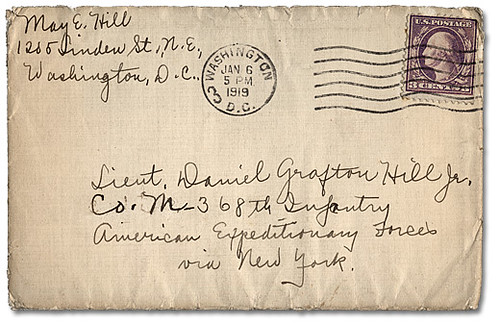Post Offices (as centers of community)

Envelope containing May Edward Hill’s letter to Daniel Hill Jr., January 5, 1919, Archives of Ontario. (Sent from the H Street NE neighborhood, DC.)
In the "old days," the local post office was a key gathering place in commercial districts, and a generator of many trips to the commercial districts. Until the massive increase in participation in local activities by the federal government, beginning in the 1960s, the local post office was the most significant local link to the "federal government." And the architecture of the buildings was decidedly "civic" and authoritative, reflecting the power and majesty of the government.
So it had been a significant loss for traditional commercial districts, in losing out to more "suburban-like" or automobile-oriented locations as the U.S Postal Service relocated many of their branches away from walkable neighborhoods and communities.
In today's digital days, as email and ubiquitous cellular (mobile) phones replace writing and mailing letters, the U.S. Postal Service is experiencing massive losses--expecting a deficit this year of $7 billion, and projecting even greater losses for next year. (Part of this is due to antiquated work rules which Congress won't allow to be changed, which prevents the USPS from rightsizing their workforce.) Although, ebay and other online sales has bumped up USPS package delivery revenues.
So, the "USPS may close 1000 post offices" (Federal Times) to deal with their revenue crash, as well as the reality that digital communications have cut into volume and demand permanently, making many stations uneconomic. But 71% of the revenues generated by the USPS are derived by post office stations.
(Also see this recent Washington Post article about mailbox removals, "So Long, Snail Shells: Mail Volume Expected to Decline; U.S. Postal Service Adapts by Pulling Collection Boxes." And this story, Biggest Post Office TO BE BUILT IN CHICAGO (Aug, 1931) from Popular Science Magazine, from the time when the mail was the most significant method of national communications.)
Here is the full list of proposed closures.
To prove that it takes awhile for things to change in the government, the President’s Commission on the United States Postal Service was created in 2002 and came out with its final report, Embracing the Future: Making the tough choices to preserve Universal Mail Service, in 2003.
Labels: federal policies and the city, media and communications, neighborhood planning, urban design/placemaking



0 Comments:
Post a Comment
<< Home